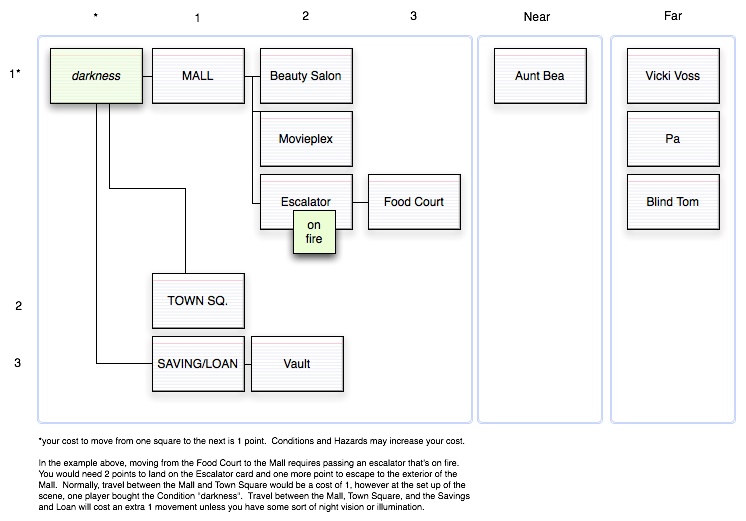One of the aspects of Meat that I haven’t talked about yet is Setting Cost. In Meat, there are two primary battle scenes (Minor and Major) that are win oriented. The other scenes won’t have direct impact on this discussion.
Game play starts with Chargen and Setting Generation (Setgen). The two are intertwined. I haven’t worked out the numbers on this yet so anything referred to below will be an abstract of the final costs.
Let’s go back to the original map, envisioned as a Minor Setting [aside, this particular example might be too complicated for a minor encounter. haven’t played it yet. hmm]

The locations in the 1 column will be referred to as Locations; locations in columns 2 and 3 will be referred to as sub-Locations (or SL for brevity). Each player will be required to create at least 50pts of setting: say Location cards cost 40 pts.; SL cards can cost at most 1/2 of the Location card they are attached to. If the Mall costs 40pts then the Movie Plex can cost as much as 20pts. [current problem: in this example the Mall is connected to the Food Court via an Escalator. I don’t know if there’s any incentive to make the Escalator smaller in pt value than the Food Court; and, or if that makes sense in the chain of events. It is possible and narratively interesting to construct a scene where the entire board is one long chain, unless i cap SL at x cards (say, 3).]
Players will start out with a pool of points to spend on Setgen and Chargen. They will have already blocked in their character but they can choose to spend points on increasing the effectiveness of their attacks; increase their Defense Reduction; buy action tokens and or buy back Assets that have become Liabilities. In addition, during Setgen, players can buy Conditions, eg. “darkness” in the example above. In response, A player that thought his character might need to move through that area quickly could buy: “night vision” for his character; or he could choose to use his points elsewhere and allow that his movement is decreased in that area. That’s a lot to do with a small pool of numbers.
Another aspect of points is that it will decide the order of player turn. The person with the most unspent Gen-points will be the first person to act in the scene. The player with the 2nd most will go second, etc. [not sure about tie breaking here]
About Setgen and play. Each battle scene will have a point value, with a number worked out to number of players x %. The minor scene will have a footprint about 60% of the Major one.
Battle and Setting and Scene. Every attack scores a point. Some points fail (doubles will render an attack a failure) however all failing points will be deducted from the Location or sub-Location card. Once you’ve reached enough points to “kill” a location you must apply a condition to that location. Conditions hamper movement through an area and conditions will also have a damage effect to npc and pcs that remain in the location. [with regard to the earlier chain of location question, this raises the issue of whether or not all the locations down-chain also fail, eg. the Escalator gets blown up and catches on fire. Per this line of thinking, the Food Court would also be on fire. I have in mind that Conditions can spread from round to round but there’s no reason here why the fire would only spread down to the Food Court and not the rest of the Mall in succession.]
Effective hits against another pc will reduce their health track. Failed hits will cause damage to the locations. Both attacks will get logged against the Scene point value. Once the Scene point value has been run down to zero, the character that ran out the clock must narrate how that Scene has dissolved. There will be a win-lose-draw score attached to all pc participants and then play will proceed to another phase.